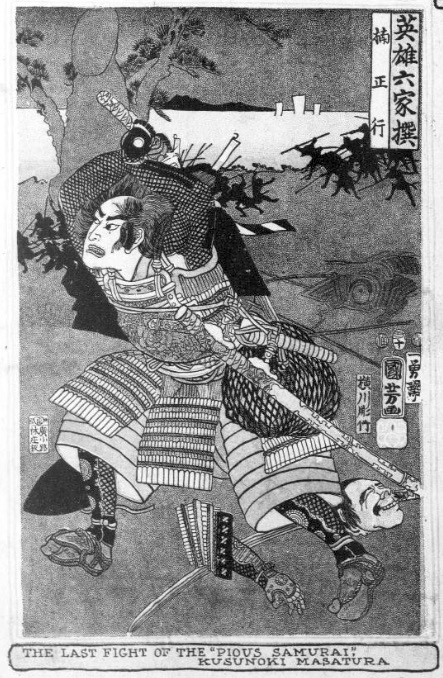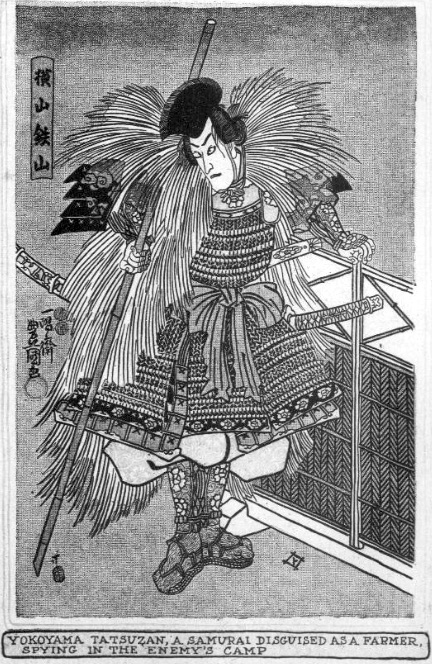
The Japanese samurai of Medieval Japan are a fascinating class of people who started off as servants and eventually became the stuff of legends. Samurai means “those who serve”. It was during the 8th century CE that the samurai were servants in the imperial court. It didn’t take long until the word samurai was applied to soldiers that were recruited by the imperial court to take on different war jobs. These samurai soldiers grew into educated landowners and men who practiced the martial arts. They took on roles similar to the policemen and body guards of today. When bandits or rebels threatened the throne, it was these men who rode out and put a stop to the trouble.
Because of their wealth, the samurai were able to afford horses. The early samurai used the bow and arrow as their weapon of choice. Later, the bow and arrow was dominated by the spear. After the spear came the well known samurai sword.
By the 11th century CE, the samurai families were well established in society and they began to become involved in politics. Warring samurai began to go to battle to decide who would take the throne after an emperor died. Eventually, by the late 1100s, Japan saw its first shogun, a military leader, and the emperor became a mere figurehead. It wasn’t until the 19th century when foreigners came and brought the modern world with them that the reign of shoguns and samurai came to an end.

1. Raising a Samurai
Raising a samurai was not the same as raising just another child. Parents were given specific instructions on how to raise a child to become a strong, fearless samurai. Parents were told not to instill fear in the child because that fear would be carried into the child’s adult life and make him a coward. The child was encouraged to go into the darkness without fear and he was taught to not fear other things, such as lightning. This meant that the parents would in turn show no fear of these things. Parents were also warned against telling the samurai child scary stories. The goal was to keep the child brave and to continuously encourage the child’s bravery in all things. Teasing a child that was meant to become a samurai was also discouraged.
2. Their Daily Schedule
Samurai had a strict daily routine that is similar to the successful business people of today’s world. Self discipline was an art taken to near extremes, but it was also a part of his every day life. The samurai would wake at 4 in the morning. He would bathe, care for his hair, and general appearance. Grooming his nails was also a part of his routine. At first light, he would eat his breakfast and then his day would begin. When the sunlight had left the sky, it was time for the samurai to go to sleep.
3. A Simple Diet
Unlike European warriors who appear as gluttons in history, the samurai maintained a very simple, healthy diet. Their base food was, of course, rice, but they also ate a wide variety of fresh fruits and vegetables while they were in season. Fish (preferably raw), seaweed, pickled ginger, and pickled plums were also a part of their diet. Soy beans, like rice, were prevalent in their diet. Soy sauce, tofu, and miso were all made from soybeans. Meat was eaten in small amounts, mostly when the samurai physically needed the proteins. The meat included wild duck, boar, venison, and badger.
4. Mistaken for Women
Curious enough, the samurai paid special attention to their hair and would grow it long, wearing it back in a pigtail during day to day life, but letting it flow long and free while in battle. The front part of their head was shaved, as is seen in today’s Japanese warrior movies. Since it was also a custom for the women to create the look of a high forehead, it became a tradition that the samurai would grow a mustache. The reasoning behind this is so that the severed head of a samurai would not be mistaken for that of a woman’s head.
5. Sword Practice Executions
To gain hands on experience with a sword, the samurai would visit the execution of criminals. There they would practice their beheading skills. In fact, learning how to behead a person was so important to the samurai that samurai boys were expected to carry out a human beheading by the age of 15. Going back to an even younger age, 5-year-old samurai boys were encouraged to kill dogs using a sword so that they could gain mastery over the sword.

6. Religious and Spiritual
The Japanese samurai, as well as most of the people of Medieval Japan, practiced all of the religions of the region. There were five religions and traditions in Medieval Japan: Shinto, Buddhism, Taoism, Confucianism, and folk beliefs. These five belief systems were practiced together and were intermingled, unlike Medieval Europe where people would gladly kill another person for being the wrong kind of Christian, Muslim, or Jew. The samurai practiced all five forms of religion and spirituality which were beyond simple beliefs and steeped in hands-on traditions.
7. Suicide
Suicide was very much a part of the life of a samurai. A samurai would take his own life, called hara kiri, to atone for his failure when he and his army was being defeated in a battle. There are numerous instances where a samurai would seek a quiet place to honorably disembowel himself after writing a poem or a letter. In other instances, a samurai might be given the choice of either dying by the hands of an enemy or suicide. In which case, suicide would be the better choice. In a third instance, a defeated leader of the samurai would be commanded to take his own life. A samurai and his men might also commit suicide in cases when the lead samurai was killed as a show of solidarity and loyalty.
8. Cleaned Heads
When the circumstances allowed it, the heads of defeated samurai and their leader were collected after a battle for a ritual of display. The severed heads were cleaned and the hair was brushed. The women who dressed the severed heads also blackened the teeth of the dead men because it was believed that honorable men used to blacken their teeth. The heads were then place on spikes on a board of wood. Names were tagged to each of the heads and the heads were displayed before the victorious feudal lord.
9. Collecting Noses
There were many instances when collecting the heads of enemies was too inconvenient. During an invasion of Korea, the Japanese warriors found it difficult to ship thousands of Korean heads back to Japan as proof of their work. Instead, they began shipping back the noses of their enemies, packed in salt. The noses were counted and documented. When they reached Japan, the noses were buried in a mound near a Great Buddha. In a battle in 1598, the noses of 38,700 Korean and Chinese men were returned to Japan and buried. The burial mounds can be visited today at the Mimizuka which deceptively translates as the “Mound of Ears”.
Source:
Warriors of Medieval Japan by Stephen Turnbull. If you have an interest in the facts behind the warriors of ancient Japan, I highly recommend this book. I bought this book on a whim and recently took the time to read it. It is a fascinating look into the lives of the samurai, ninja, and warrior monks.


